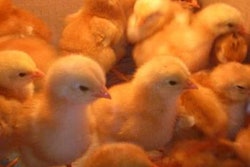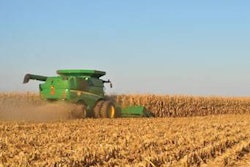This year’s North America corn crop contains a mixture of molds and mycotoxins, putting broilers, layers and pigs at risk for mycotoxin exposure and a loss in average daily gain, according to a recent survey by Alltech.
A survey of 46 North American corn samples from across the United States and Canada from September to November 2014 tested for mycotoxin contamination through Alltech’s 37+ mycotoxin analysis found an average 4.6 mycotoxins per sample. This year’s analysis took the information from the survey one step further, revealing the costs associated from mycotoxin contamination and what poultry and pig producers can save by utilizing Alltech Mycotoxin Management.
“Based on Alltech’s 37+ results of the 2014 corn harvest, we see that the risk of mycotoxins to broilers is moderate. Scientific literature shows that at a similar risk level, broilers may have a 5.3 percent reduction in average daily gain when consuming mycotoxins,” said Dr. Alexandra Weaver, Alltech Mycotoxin Management Team. “Additionally, feed conversion rate (FCR) may increase by about 2.6 percent. With this loss of performance, the reduction in net return for broilers is an estimated decrease of $0.18 per bird.”
The same analysis showed that the risk of mycotoxins to pigs was also substantial, with a reduction in net return per nursery pig at an estimated decrease of $4.21.
Weaver, who examined more than 90 peer-reviewed papers, said on average mycotoxins cost the broiler industry a 5.1 gram decrease in average daily gain per day and a 0.11 increase in FCR, resulting in a deficit of $0.34 per bird. For layers, Weaver calculates the average shortfall is 1.7 eggs lost per week, a 0.38 increase in FCR and an overall loss of $0.14 per hen per week.
In pigs, Weaver added, mycotoxins on average cost nursery pig producers an 81 gram decrease in average daily gain and a 0.96 increase in FCR, and a loss of $7.42 per pig.
Many times it is not an acute case that can be readily identified, but a chronic situation associated with the ingestion of a low level of mycotoxins over an extended period of time. This results in a wide array of subclinical symptoms that slowly reduce performance, eat away at the producer’s bottom line and compromise animal health.
“While we boasted a record crop this year, quantity does not determine quality,” said Dr. Max Hawkins, nutritionist with Alltech’s mycotoxin management team. “This year’s cool, wet weather delayed planting and harvesting and now that harvest is complete, we are dealing with storage and transportation issues that are putting the 2014 crop at additional risk for mycotoxin growth.”
Hawkins said while East Coast samples contained more mycotoxins with an average 5.7 per sample, Midwest and Canadian grains still should be a concern for poultry and pig producers as Alltech’s Risk Equivalent Quantity (REQ) puts North America corn at a moderate to high risk level.















